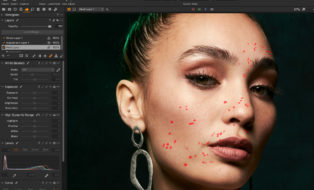In Capture One Pro 7, we have introduced a new processing engine improving the image quality on a number of different parameters such as the way the software now deals with extreme highlights and data close to being clipped.
These aspects have been dramatically improved and now have:
- Larger range for how much overexposure that can be recovered
- Color precision is greatly improved in recovered areas
- Much smoother transition to clipped data
- More detail in the highlight areas
 Camera generated JPG Capture One Pro 6 Capture One Pro 7
Camera generated JPG Capture One Pro 6 Capture One Pro 7
The image above shows three different versions of the same shot. The left side image is the JPG that was generated in the camera. The center image is the result of recovering highlights in the raw file using Capture One Pro 6. The image to the right is the same raw file but now processed in Capture One Pro 7.
Using Capture One Pro 7 it was possible to recover almost all the detail and color tones in the overexposed areas of the swan by using only the Highlight slider in the High Dynamic Range tool.
Visit the blog to see more examples of the improved ability to recover highlights
Below is another example of the new and improved processing engine’s ability to recover color and detail by using Capture One Pro 7 on a raw landscape image.
 Camera generated JPG Capture One Pro 6 Capture One Pro 7
Camera generated JPG Capture One Pro 6 Capture One Pro 7
With the JPG file, it is not possible to recover any color and detail in the sky. By processing the raw file in Capture One Pro 6, you can recover most of the sky, but the color information is wrong and the missing color information will show with hard transitions. With Capture One Pro 7 however, it is possible to recover both the detail in the clouds and the color of the blue sky in a natural and pleasing way.
For both raw files, the High Dynamic Range tool was used to recover the highlight detail. Some global saturation was also added.
When shooting landscape images using natural light, it can sometimes be quite challenging to control the highlights as you cannot control the light source. And even when you can control the light, you may still need the ability to recover highlights.
Many of us have tried shooting a portrait in the studio only to misadjust the flash just as the expression was just perfect, like in the example below.
 Raw file – way overexposed Capture One Pro 6 recovery
Raw file – way overexposed Capture One Pro 6 recovery
This image is totally overexposed due to a human error with the flash and even though Capture One Pro 6 can recover a majority of the image, it will still require many hours of retouching to save it.
However, with Capture One Pro 7 it is possible to recover all the highlight detail. The image above has only been adjusted by using the Exposure tool globally as well as the Exposure tool in a Local Adjustments mask in Capture One Pro 7.
All the best,
Niels

The Image Quality Professor
The digital pioneer, Niels V. Knudsen, is Phase One’s Image Quality Professor and founder of the IQP blog. Moreover, he is responsible for breakthrough advancements in image quality both in Phase One’s medium format camera systems and in Capture One Pro.





Could you please post the highlight recovery video tutorial for the portrait using CO7?
Hi Kevin,
You can find our tutorial about highlight recovery here: http://www.phaseone.com/en/Imaging-Software/Capture-One-7/Tutorials.aspx
All the best,
Niels
Hi,
Thanks for your really good illustration of he highlights recovery feature.
I am highly interested by the landscape image that is used in this test, to perform some additional tries on my own.
May I ask you the corresponding RAW file?
Best,
Yann
When creating a style preset I see under Exposure options to save settings for Highlight and Shadow Recovery. BUT they’re not show in the exposure tool. I need to access those as part of my workflow. How do I get them?!
Hi Eric,
They are in their own tool called HDR.
David